Not sure why your enhanced brand content won’t pass Amazon’s inspection? Here’s a list of the 10 most common reasons why your EBC or A+ Content is getting rejected and how to fix it.
Frequently Asked Questions About EBC Restrictions and the Approval Process
Knowledge is power. Being familiar with all the details about how the A+ Content or EBC approval process works can keep you from being rejected.
How does Amazon review my contribution?
All text and images within A+ Enhanced Brand Content, including in text boxes, image keywords, and text embedded in images are subject to both automated and manual review.
What does my EBC being rejected mean?
After you upload your content as a draft and apply ASINs in Seller Central, you will see the content status within the A+ Content Manager page change to “in review.”
Can I have both a product description and an EBC?
No, the A+ content will hide the current plain-text product description.
If you feel like your product description content was necessary, you can incorporate that within an enhanced brand content module that allows plain-text descriptions.
What ASINs can I add content to?
You can publish content to all ASINs that you own as a registered brand owner in Amazon Brand Registry and have an offer. If the ASIN has A+ content contributed by an Amazon retail vendor, you will not be able to add or edit content.
How long will it take for my EBC to be approved?
Amazon states that they will either approve or reject enhanced brand content within 7 days. However, in our experience, most EBC’s will be approved within 24 hours during non-peak seasons.
Approvals can take longer during the holiday season.
How will I know if my EBC content is approved or rejected?
If your EBC is classified as “approved” under the content status on the A+ Content Manager page your content is live! You will be able to see it in the product description section of the specific ASIN’s product detail page.
If your EBC is shown as “rejected” after you submit it for publishing, it means that Amazon’s algorithm has found that the content doesn’t abide by Amazon’s best practices.
Why is my EBC being rejected?
Amazon’s approval system is necessary because it catches a variety of prohibited content, which we’ll get into below.
Why is a rejected EBC important?
This is an easy one, so we’ll answer your question with another question: what’s the point of spending the time and investment of having these assets made if it can’t even get past Amazon’s publishing system?
In our experience as an Amazon optimization agency and brand owners ourselves, having an EBC get rejected can be a warning sign.
Because the content within an EBC indicative of the content within images and bullets, it can set off a very expensive avalanche of red flags that can cause your listing and eventually your account to be suppressed if you’re not careful. These consequences can become very time-consuming and can cost you thousands trying to restore your account.
In short, if your products’ enhanced brand content is getting rejected, it’s likely that it will lead to bigger problems down the road if Amazon sellers don’t take action quickly.
EBC Restrictions That Keep You in Drafts
You’ll have to abide by all category requirements or Selling on Amazon policies when writing about or creating images for enhanced brand content.
If you’re not violating any of those big rules, here’s a list of specific solutions to help you identify why your enhanced brand content is being rejected by Amazon.
1. Prohibited Keywords and Terms
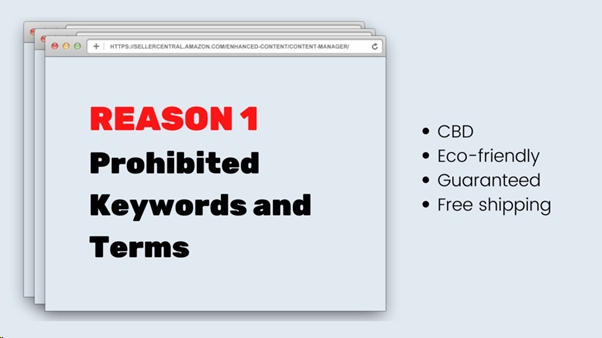
All text entered in A+ Content, including in text boxes, image alt-text keywords, and text embedded in images are subject to both automated and manual review and validation against a list of prohibited keywords and keywords that may be prohibited in certain contexts. Incorporating banned keywords can prevent you from publishing your content until it’s fixed.
In general, using restricted keywords such as prescription drug names or ingredients is a surefire way to get rejected. You’ll want to reference Amazon’s list of restricted products to make sure none of those product names is accidentally in your keywords.
Having any variation of keyword phrases, including but not limited to these, are often rejected immediately:
- CBD and any of its variants like CBD oil, full-spectrum CBD, and so on
- Neem
- Antibiotic
- Antibacterial
- Any prescription drugs
Even regular words can be grounds for an EBC rejection in certain contexts, which includes but aren’t limited to these phrases:
- Eco-friendly
- Guaranteed
- Free shipping
- #1
- Any brand name except your own
- Referencing holidays
2. Text Errors
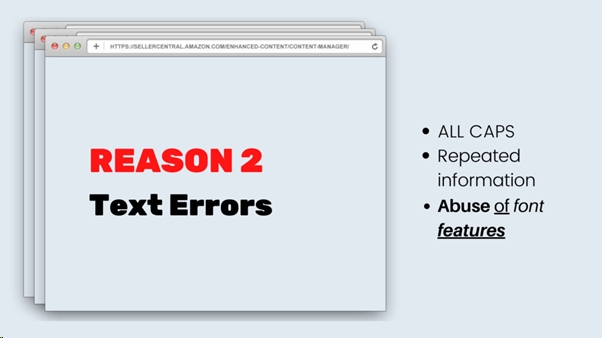
Grammatical errors, punctuation errors, misspellings, strings of all-caps text, abusing font features, or unnecessary or repeated information. Bold and italic formatting is only intended to be used to highlight headings or a few select words.
3. Unverified Claims
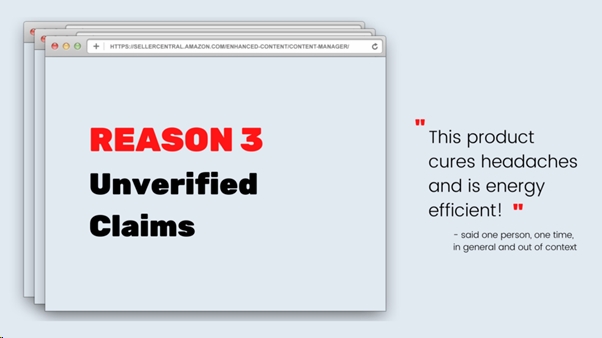
Energy-saving claims
In accordance with the FTC’s stance on energy-efficiency claims, you should avoid making any without scientific proof.
Any claim about the efficiency, energy savings, fuel consumption, operation cost, cost recovery, or “payback” of an energy-saving product must be truthful and backed up by competent and reliable scientific evidence before you make the claim.
Health claims
In accordance with the FTC’s stance on health and nutrition claims, you should avoid making any outlandish disease claims without scientific proof.
Additionally, if the content within your EBC makes claims without an FDA disclaimer present, it will be rejected.
4. Referencing your company
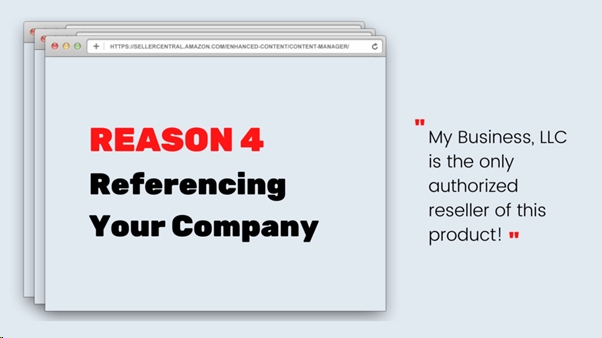
In your enhanced brand content, you can’t provide any external company contact information within your EBC. You are not allowed to redirect to other sites, so having any language attempting to redirect customers to your business site is grounds for rejection.
Likewise, if you’re referring to your company as sold by authorized resellers, your EBC will be rejected. To add to this point, it’s also important for you to remember that if you’re selling your own brand on Amazon, anyone who lists your product can have the same images and EBC that you create be applied to their listing.
5. Use of FDA logo
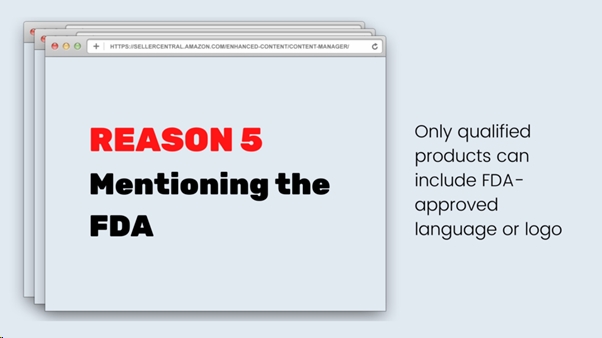
Products that claim to be “FDA Cleared,” “FDA approved” or products that include the FDA logo in associated images need to meet additional requirements
6. Use of copyright trademark
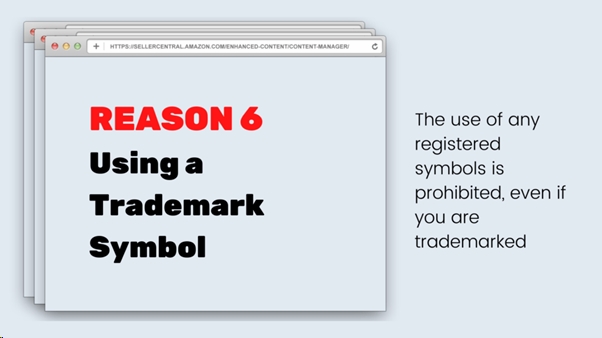
The use of any registered symbols is prohibited. This includes, but isn’t limited to:
- ®
- ©
- ™
If you’re having trouble with this feedback from Amazon, double-check that any of the product images within the enhanced brand content don’t contain any of these symbols. Even though your brand logo may actually have a copyrighted trademark or registered Amazon still doesn’t allow a seller or distributor.
Oftentimes, trademark symbols can be camouflaged to the naked eye, but not to the algorithm.
7. Using more than 2 quotes
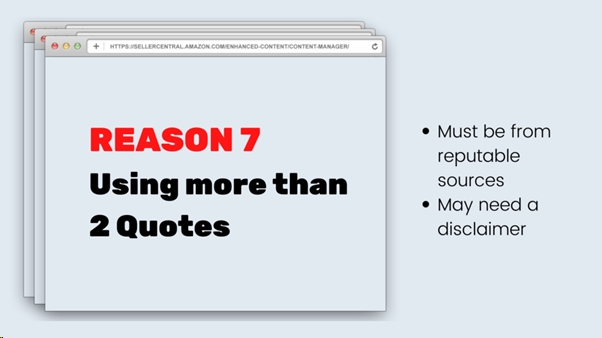
Quotes must be from well-known publications or public figures, and there’s a maximum limit of 2. If you incorporate product award information, it must be presented with a disclaimer stating the source.
Additionally, even adding stars to illustrate a top review is grounds for rejection. Though there’s no concrete reason for this, we assume that it’s because the algorithm views it as an attempt to mimic Amazon details.
8. Poor-quality images
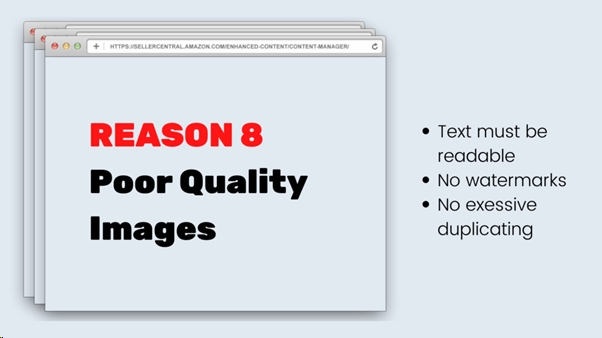
In general, blurry or low-quality images can hurt your conversion rate so it’s really in your best interest to incorporate the best assets you can. You’ll want to avoid:
- Images containing watermarks or unreadable text; font size must be 16 or larger
- Lifestyle images not showing the product (unless they are used to tell the brand story)
- Content that duplicates many of the images from the main image block on the detail page
9. The ASIN is not recognized as part of your brand
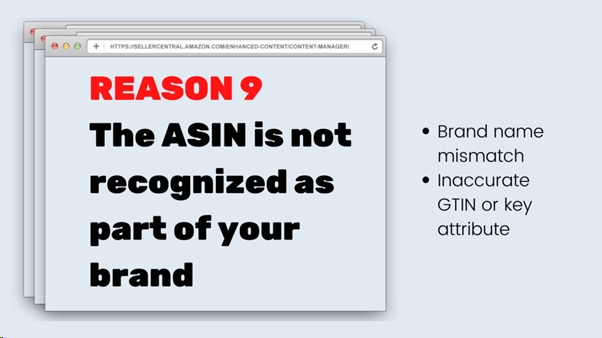
This message means that the ASIN is not properly being mapped to your brand. Often, it’s because the brand name associated with that specific product may be different than what you have been approved for through brand registry.
The most common data points that need updating are:
- The brand name listed on the ASIN does not match the brand name as approved by Amazon’s Brand Registry. These need to match 100%. Using spaces, capital letters, lowercase letters, or hyphens will lead to a mismatch.
- Inaccurate GTIN or Key Attribute. When you registered your brand, you provided a GTIN or selected a Key Attribute (KA). This attribute must be included in your ASIN listing data. The most common GTIN/KAs are:
- UPC
- Part number
- Model number
- Style number
- Catalogue number
- The item type category which closely matches the ASIN product type should be selected in the listing details
To fix this, you’ll have to locate the inaccurate information within the listing data and update it. Within the Manage Inventory tool in Seller Central, select EDIT on that ASIN. If you still receive this error after verifying these data points, please contact the Brand Registry for assistance.
10. None of the Above
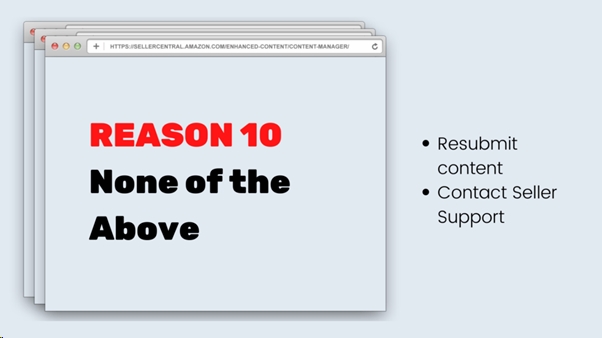
If you’re 100% sure that your content doesn’t commit any of the offences above, you’re not going crazy. It’s not you, it’s Amazon.
Sometimes you’re not doing anything wrong. Sometimes the algorithm is just sensitive. In this instance, you have two options: resubmit or contact Amazon seller support/brand registry.
Resubmitting
If you’ve checked all of the above and still haven’t been approved, you can manoeuvre the algorithm into thinking you’ve made changes by adding a period “.” into one of the text modules. Doing this will restart the approval process instead of receiving an automatic rejection.
Contact Support
If all else fails, you can always open a case with Amazon seller support.



